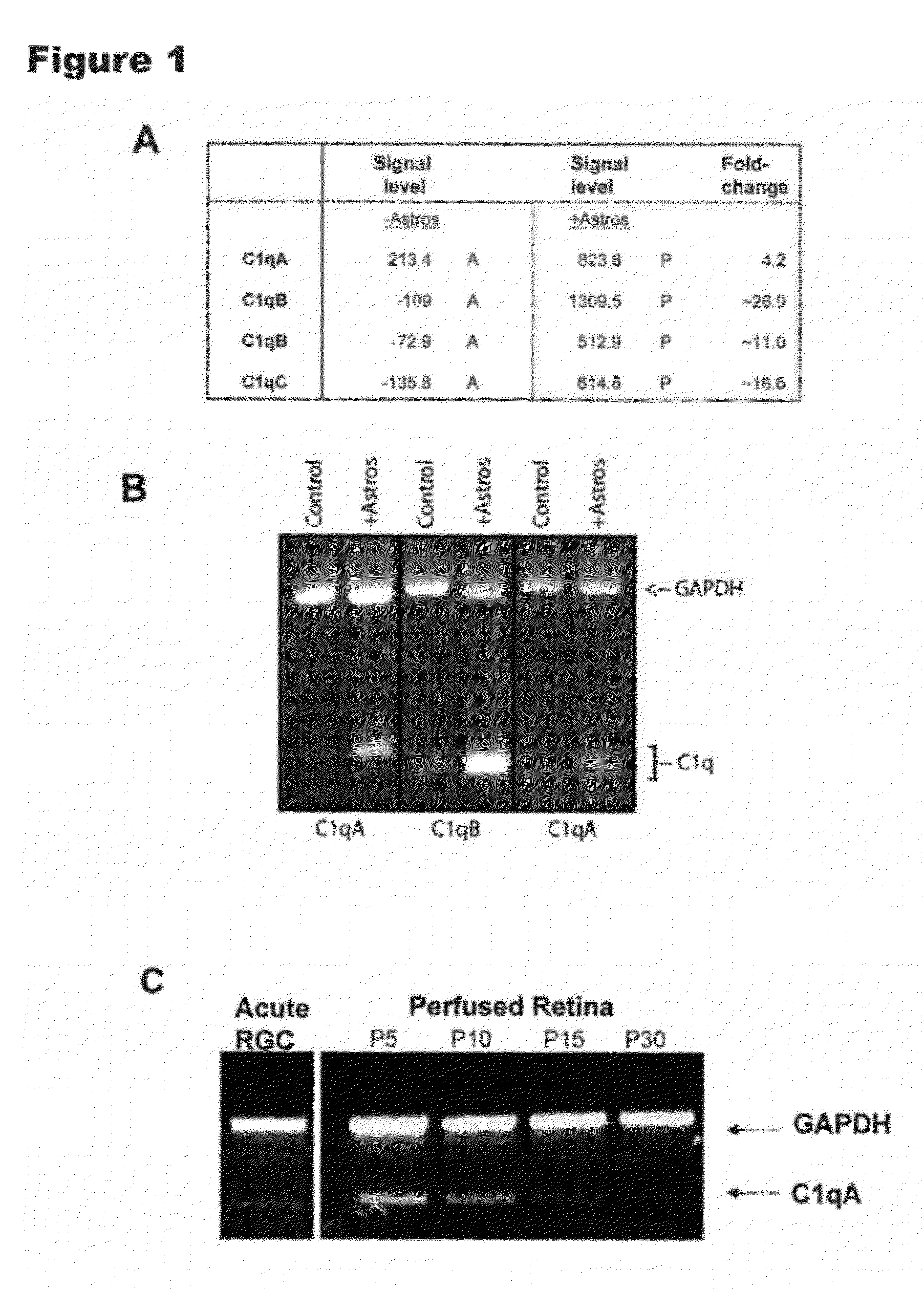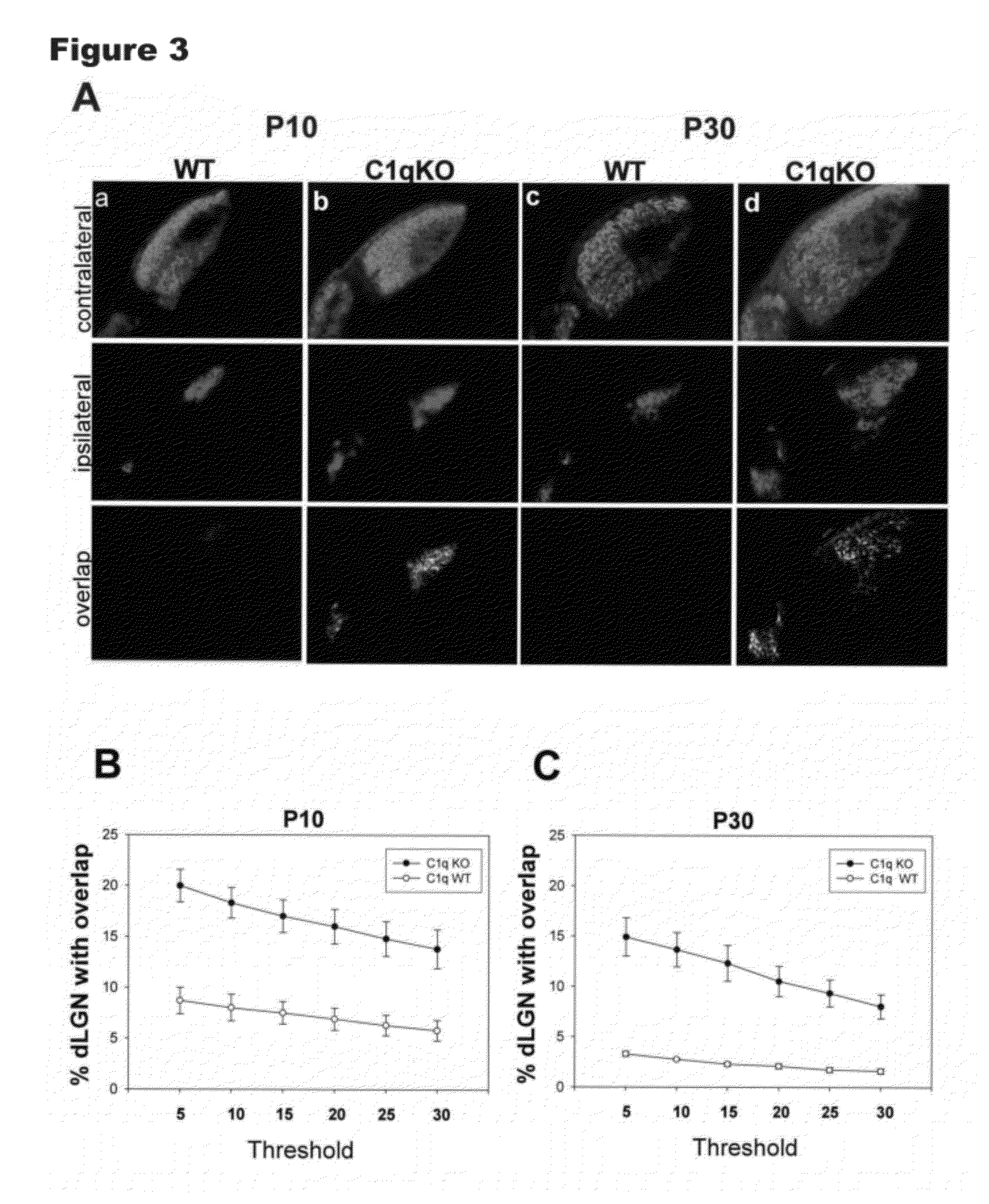Modulation of Synaptic Maintenance
a technology of synaptic maintenance and maintenance, applied in the field of synaptic maintenance, can solve the problems of post-synaptic receptor disassembly and withdrawal of axons, further complicated interpretation of these findings about synaptic density counts, and impairment of that system's functioning, so as to prevent the elimination of synapses from neurons
- Summary
- Abstract
- Description
- Claims
- Application Information
AI Technical Summary
Benefits of technology
Problems solved by technology
Method used
Image
Examples
example 1
Methods
[0141]RGC Gene Expression Analysis Using Affymetrix GeneChip Arrays:
[0142]Purified RGCs were plated at a density of −100,000 cells per well in 6-well dishes and cultured in the presence or absence of a live astrocyte feeding layer for four days. Total RNA was harvested using RNeasy Mini Kit (Qiagen). cDNA was synthesized from 2 μg total RNA using the Gibco BRL Superscript Choice system and a T7-(dT)24 primer [5′-GGCCAG-TGAATTGTAATACGACTCACTATAGGGAGGCGG-(dT)24-3′ (SEQ ID NO:1)]. Biotinylated cRNA target was prepared by T7 linear amplification using the Bioarray RNA Transcripts Labeling Kit (Enzo) followed by fragmentation. Target was hybridized to Affymetrix Test-2 GeneChip arrays to assess target performance and the Rat U34 genome GeneChip array set following standard Affymetrix protocols. Microarray data was generated in paired triplicates from three independent cultured RGC preparations. Assessment of the quality of sample data and changes in gene expression were analyzed w...
example 2
[0188]The decline of cognitive function is one of the greatest health threats for the aging population. It has been widely accepted that it is primarily loss of synaptic connections, rather than loss of neurons per se, that is responsible for age-associated cognitive impairment in otherwise healthy individuals. In rats, these aging changes are particularly prominent in the dentate gyrus where decreased synapses, decreased EPSPs, decreased LTP, and spatial memory deficits occur (Morrell, PNAS, 1986; Barnes, J. Comp. Physiol. Psych. 1979; Lynch, J. Gerontology, 1977).
[0189]As demonstrated in example 1 above, a vast loss of synapses occurs normally within the developing brain as neural circuits are sculpted. This developmental CNS synapse elimination is mediated by complement component C1. The known role of Clq, when activated, is to trigger the onset of the classical complement cascade, causing destruction and elimination of pathogens, apoptotic cells and debris.
[0190]To investigate w...
example 3
[0198]Wild type mice and C1q-deficient mice were assessed using several electrophysiological tests to determine the state of decline in function of hippocampal neurons at 3 months of age, 9 months of age, and 15 months of age. This included assessing the Perforant Path / Dentate Gyrus synaptic pathway for input output curves of dentate gyrus molecular layer field potentials, which measure the relationship between stimulus size and the size of the evoked synaptic response to address synaptic properties or architecture; the Perforant Path / Dentate Gyrus pathway for paired-pulse facilitation, which measures the rapid succession of two presynaptic stimuli; and the Perforant Path / Dentate Gyrus pathway and Schaffer collateral / CA1 pathway for long-term potentiation, which measures the extent of long-lasting enhancement in signal transmission between two neurons that results from synchronus, high-frequency stimulation.
[0199]In addition, wild type mice and C1q-deficient mice were assessed using...
PUM
| Property | Measurement | Unit |
|---|---|---|
| time | aaaaa | aaaaa |
| neurodegenerative disorder | aaaaa | aaaaa |
| synaptic density | aaaaa | aaaaa |
Abstract
Description
Claims
Application Information
 Login to View More
Login to View More - R&D
- Intellectual Property
- Life Sciences
- Materials
- Tech Scout
- Unparalleled Data Quality
- Higher Quality Content
- 60% Fewer Hallucinations
Browse by: Latest US Patents, China's latest patents, Technical Efficacy Thesaurus, Application Domain, Technology Topic, Popular Technical Reports.
© 2025 PatSnap. All rights reserved.Legal|Privacy policy|Modern Slavery Act Transparency Statement|Sitemap|About US| Contact US: help@patsnap.com



